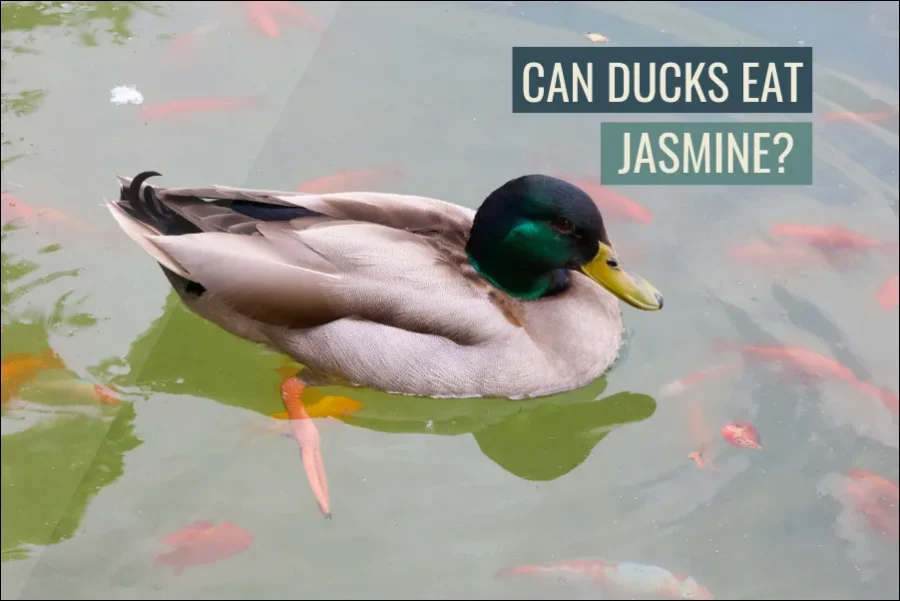
The morning dew clings to jasmine flowers as a family of mallards waddles past your garden pond. You watch them forage and wonder – could these fragrant white blooms be a safe treat for your feathered visitors?
Most jasmine varieties are toxic to ducks and should be avoided. While true jasmine (Jasminum species) contains compounds that can cause digestive upset and neurological symptoms in waterfowl, some plants called “jasmine” like confederate jasmine are even more dangerous.
Why Jasmine Is Dangerous for Ducks
Jasmine contains alkaloids and glycosides that ducks cannot properly metabolize. When consumed, these compounds can interfere with their nervous system and digestive tract. Wild ducks typically avoid jasmine instinctively, but domestic ducks or those accustomed to human feeding may not recognize the danger.
The concentration of toxic compounds varies between jasmine species, with some being mildly irritating while others can cause severe poisoning. Even small amounts can trigger symptoms in smaller duck breeds or young ducklings.
Symptoms of Jasmine Poisoning in Ducks
If a duck consumes jasmine, watch for these warning signs within 2-6 hours:
- Excessive drooling or foaming at the beak
- Difficulty walking or loss of coordination
- Rapid breathing or panting
- Vomiting or diarrhea
- Lethargy and weakness
- Tremors or seizures in severe cases
These symptoms indicate the need for immediate veterinary attention. The sooner treatment begins, the better the duck’s chances of recovery.
Different Types of Jasmine and Their Toxicity Levels
Not all plants called “jasmine” are equally dangerous, but none should be offered to ducks:
True Jasmine (Jasminum officinale) contains moderate levels of toxic alkaloids. While not immediately fatal, it can cause significant digestive distress and neurological symptoms.
Confederate Jasmine (Trachelospermum jasminoides) is extremely toxic to birds and can cause rapid onset of severe symptoms, including cardiac issues.
Star Jasmine shares similar toxicity concerns with confederate jasmine and should be considered highly dangerous.
Carolina Jasmine (Gelsemium sempervirens) contains gelsemine, one of the most potent plant toxins affecting birds, and can be fatal even in small quantities.

Safe Flower Alternatives for Ducks
Instead of risking jasmine exposure, offer these duck-safe flowers and plants:
Dandelions are excellent for ducks and provide vitamins A and K. Both flowers and leaves are safe and nutritious.
Clover blossoms offer protein and are naturally attractive to waterfowl. White and red clover varieties are both acceptable.
Rose petals (pesticide-free) make a safe occasional treat, though remove thorns from any stem pieces.
Nasturtiums provide peppery flavor that many ducks enjoy, plus vitamin C and natural antibacterial properties.
When introducing any new food, start with small amounts and observe for any unusual reactions.
How to Duck-Proof Your Garden
If you have jasmine plants and frequent duck visitors, take these precautions:
Create physical barriers around jasmine plantings using decorative fencing or plant cages. This allows you to enjoy the fragrance while keeping curious ducks at bay.
Position water features and feeding areas away from jasmine plants to reduce the likelihood of accidental consumption.
Consider replacing jasmine with duck-safe landscaping options that provide similar aesthetic appeal without the safety concerns.
Regular pruning prevents fallen jasmine flowers and leaves from accumulating where ducks might encounter them.
What to Do If a Duck Eats Jasmine
Contact a veterinarian immediately, even if symptoms haven’t appeared yet. Early intervention significantly improves outcomes.
Do not attempt to induce vomiting unless specifically instructed by a veterinary professional, as this can sometimes worsen the situation.
Provide fresh water to help dilute any toxins, but avoid forcing the duck to drink excessive amounts.
Move the affected duck to a quiet, safe area away from other birds to prevent stress and allow for easier monitoring.
Keep a sample of the consumed plant material to help the veterinarian identify the specific toxin involved.
Creating a Duck-Friendly Environment
Ducks thrive when provided with appropriate nutrition and safe foraging opportunities. Focus on offering healthy treats like leafy greens and specially formulated waterfowl feed rather than relying on garden plants.
Understanding which plants pose risks helps you make informed decisions about landscaping and feeding practices. When in doubt about any plant’s safety, research thoroughly or consult with local wildlife experts.
Common Myths About Ducks and Flowers
Many people believe that if a plant grows naturally, it must be safe for wildlife. This misconception leads to well-meaning individuals offering jasmine and other toxic plants to ducks. The reality is that wild ducks have evolved specific dietary preferences and avoidance behaviors that domestic or semi-domestic ducks may have lost.
Another persistent myth suggests that ducks will instinctively avoid harmful plants. While this is often true in natural settings, ducks in urban environments or those accustomed to human feeding may not recognize garden plants as potential threats. Their natural wariness can be diminished by regular human interaction.
The belief that “a little bit won’t hurt” is particularly dangerous with jasmine. Even small quantities can accumulate in a duck’s system, and what seems like a harmless nibble today could contribute to toxicity when combined with future exposures.
Understanding Duck Digestion and Plant Toxins
Ducks have a unique digestive system that processes plant matter differently than mammals. Their gizzard helps break down tough plant materials, but this mechanical grinding can also release concentrated toxins from certain plants more efficiently.
The pH levels in a duck’s digestive tract can intensify the effects of alkaloids found in jasmine. What might cause mild stomach upset in a larger animal can trigger severe neurological symptoms in waterfowl due to their faster metabolism and different biochemical processes.
Young ducklings are especially vulnerable because their detoxification systems are still developing. Their smaller body weight means that even tiny amounts of jasmine can reach dangerous concentration levels quickly.
Regional Variations in Jasmine Toxicity
Climate and soil conditions can affect the concentration of toxic compounds in jasmine plants. Jasmine grown in stressful conditions, such as drought or poor soil, may produce higher levels of defensive alkaloids as a survival mechanism.
Seasonal variations also play a role, with spring growth often containing the highest concentration of toxic compounds. This coincides with peak breeding season when ducks are most active and may encounter jasmine while foraging for nesting materials.
Different geographical regions may have varying jasmine cultivars, some bred for reduced toxicity in ornamental settings, while others maintain high levels of natural plant defenses. Never assume that jasmine in your area is safer than elsewhere.
Professional Wildlife Rehabilitation Insights
Wildlife rehabilitation centers frequently treat birds suffering from plant poisoning, with jasmine being a common culprit. Rehabilitators report that recovery rates depend heavily on the speed of treatment and the amount consumed.
Experienced wildlife veterinarians note that jasmine poisoning often presents alongside other toxicities, as affected ducks may consume multiple harmful plants in their weakened state. This complicates treatment and emphasizes the importance of prevention.
Many rehabilitation facilities now include jasmine awareness in their community education programs, recognizing that public knowledge significantly reduces the number of poisoning cases they treat annually.
Long-term Health Effects
Ducks that survive jasmine poisoning may experience lasting effects on their nervous system function. Some exhibit coordination problems or reduced foraging efficiency for weeks or months after recovery.
Reproductive health can also be impacted, with some studies suggesting that jasmine toxins may interfere with hormone production and egg development in female ducks. This has implications for both individual birds and local duck populations.
Chronic low-level exposure, while not immediately fatal, can weaken a duck’s immune system and make them more susceptible to diseases and parasites. This is particularly concerning for wild populations that may encounter jasmine regularly in suburban environments.
Building Community Awareness
Educating neighbors about jasmine dangers creates safer environments for local duck populations. Many homeowners are unaware that their landscaping choices affect wildlife and are willing to make changes when informed.
Community gardens and public spaces present opportunities to replace jasmine with native plants that support local wildlife while maintaining aesthetic appeal. These collaborative efforts benefit entire duck populations rather than just individual birds.
Social media and local wildlife groups can help spread awareness about plant toxicity, creating networks of informed individuals who can monitor and protect visiting waterfowl in their neighborhoods.
